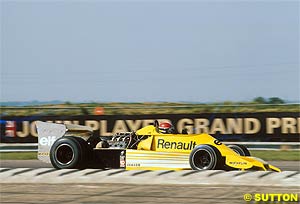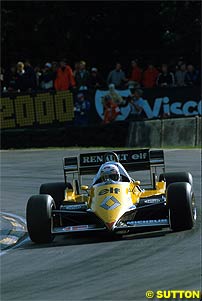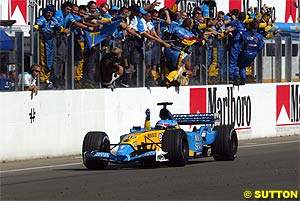
Atlas F1 Senior Writer
Since its first victory in 1906, the Renault name has been associated with success. A shaky Formula One debut in 1977 did not stop the French squad from living a very successful stay, both as a team and as an engine supplier. Atlas F1's Thomas O'Keefe looks back at the history of Renault in motorsports
While not overlooking gaps in Renault's Grand Prix history, it is fair to say that there is a direct lineage from Hungarian Ferenc Szisz's 1906 win in the 4-cylinder maroon-painted Renault AK ridng on Michelins, to the blue and yellow Renault R24 V10 Grand Prix car, also running on Michelin's, which is to be launched in Palermo, Italy on January 29, 2004 and is to be driven by Spain's Fernando Alonso and Italy's Jarno Trulli. As always, Renault presents itself as it wants to be perceived by the world at large: as an international company with a French accent.
And certainly Renault had its birth on the streets of Paris and its environs. It is not by coincidence that some of the earliest car races were from or to Paris, then a hotbed of automotive pioneering, with Marcel and Louis Renault in the thick of it as drivers and manufacturers: Paris-Rouen (1894), Paris-Bordeaux-Paris (1895), Paris-Marseilles-Paris (1897), Paris-Amsterdam-Paris (1898), Paris-Lyon (1900), Paris-Toulouse (1900), Paris-Innsbruck-Vienna (1902) and the tragic Paris-Madrid (1903) race, which was stopped prematurely at Bordeaux after a series of fatal accidents, including the death of Marcel Renault on May 26, 1903, at age 31, driving the car that bore his name. Louis Renault, Marcel's youngest brother, was also in the race and finished second in another Renault behind the Mors of Fernand Gabriel.
Louis Renault, having gone on to build Renault into a successful international company, died on October 24, 1944 at 67 years old, a month after being imprisoned by "Free French" forces for allegedly "trading with the enemy" during the war years when Germany occupied France, his plants having been pressed into service to build armaments. Because Louis Renault died before he could defend himself, we will never know the full story. His brother Marcel faired better in French memory: in Paris, there is a street named after him, Rue Marcel Renault, which is located in an area of Paris that served as an incubator for the nascent French automotive industry.
Not surprisingly, once Louis Renault began to capitalize on the racing success of Renault in the early 1900's, the company found itself consumed with filling orders for cars, taxis, vans and small buses and somewhat neglected further development of its Grand Prix cars. After the 1906 ACF victory, Renault confined itself essentially to upgrading the increasingly obsolete 1906 Renault AK through 1908, when the Renault AQ was the car that appeared in events such as the 1908 French Grand Prix at Dieppe, finishing in eighth place. A Renault 35 CV did win the New York 24-hour endurance race of 1909. After that, Renault as a Grand Prix force gave way to other French manufacturers like Peugeot and Delage, to Italian carmaker Fiat and to the increasingly dominant German teams of Mercedes and Benz, then organized as separate companies, who began to hold sway.
Amazingly, although Renault could make the 1.9 litre V6 turbo last 24 hours at Le Mans, over at the emerging Renault Formula One operation, the same team was tearing its hair out trying to keep the 1.5 litre V6 turbo alive for less than two hours, the duration of a Grand Prix. Derided as "The Yellow Teapot" by Ken Tyrrell and the other English teams running normally-aspirated engines because of the Renault's frequent turbo fires, even Renault's principal driver, Jean-Pierre Jabouille, would come to be frustrated by the inability of the early cars to finish a race.
In 1977, the inaugural year of the program, Renault entered Formula One mid-season at Silverstone for the British Grand Prix and failed to finish any races at all that season. Embarrassingly, at Mosport for the Canadian Grand Prix, "Equipe Renault Elf" could not even qualify Jabouille's Renault RS01. Under the circumstances, Renault did not even bother to make the trip to Fuji for the Japanese Grand Prix, which was the last race of the season.
In 1978, the situation improved somewhat, as the RS01 finished five times out of 14 races, with Jabouille scoring Renault's first points at the U.S. Grand Prix at Watkins Glen, finishing in fourth place, having qualified ninth on the grid. But one week later in Montreal, the inconsistency of the fledgling Renault team again manifested itself at a Canadian Grand Prix, with Jabouille qualifying dead last in a 22-car field, this dismal performance coming just months after Renault's triumph at Le Mans in the Renault sports car.
As of the end of the 1978 season, the Renault Grand Prix car, while it had the fit and finish of a first class team and looked and sounded the part, had an absolutely miserable reliability record, managing to complete only five of the 19 races it had entered.
In later years, the tall, blond and handsome Jabouille, who himself was technically astute and could be seen on occasion in the pits wielding a wrench on the RS01, not surprisingly blamed Renault Sport management, not the driver, for the teams failure to jell, telling French filmaker Alain Boisnard in an interview contained in Boisnard's Formula One Saga that "[f]or a while at Renault, they did not take enough notice of the drivers. Because I was so demanding, I was forbidden to go to the factory as I was thought to be a disturbing influence. And when I left the team, they told me that I was in a hurry to win and they were not. When a manger tells you that it's very revealing."
Returning to Jean-Pierre Jabouille's era, however, despite the undercurrents behind the scenes between labor and management, Jabouille was a loyal Renault soldier, having driven some form of Gordini or Renault-powered racecar throughout his entire racing career, including Le Mans, Formula Two and now Formula One. So Jabouille returned to the team for the 1979 season despite the disappointments of 1977 and 1978 and for a time the long hours of testing which Jabouille had been enduring since 1976 seemed to be paying off when Jabouille and the RS01 took pole position at Kyalami on March 3,1979.
Finally, on July 1, 1979, it all came good for Jabouille and Renault at Dijon for the French Grand Prix when he won the race before an appreciative home crowd, nearly two years from the team's first race at Silverstone. But even at this zenith of a moment for himself and Renault, Jabouille was robbed of taking center stage as the TV cameras covering the closing laps of the race focused on the famous and furious battle being waged between Gilles Villeneuve in his Ferrari and Jabouille's Renault teammate, Rene Arnoux, who had his hands full in a thrilling, wheel-banging finish that Villeneuve ultimately won, consigning the other Renault to third place.
Nevertheless, once the race was over, the photo of the two Renault RS 10's at the finish line of the 1979 French Grand Prix has remained the highwater mark for Renault as a constructor, second only to the 1906 victory at the ACF Grand Prix. Although Renault would stay in Formula One until the 1985 season and score 14 more victories with drivers as talented as future World Champion Alain Prost (who scored nine of Renault's 15 wins), but both the World Drivers' Championship and the World Constructors' Championship have eluded Renault to date, the nearest misses being Prost's heart-breaking loss of the Drivers' title in 1983 to Nelson Piquet's Brabham BMW turbo, a Brabham team then owned by Bernie Ecclestone; in 1983, Renault was also second best in the Constructors' Championship, its best showing to date.
After losing the 1983 Championships, Prost left the team, and there were no more wins from Renault during its tenure through 1985 as a Grand Prix constructor; indeed, it is probably significant that in 1985, Lotus had the same Renault V6 turbo and won three races (including most spectacularly Ayrton Senna's first win in the 1985 Portuguese Grand Prix at Estoril in the wet), while the works Renault team drivers, Derek Warwick and Patrick Tambay had no wins in their Renault RE 60B's, the last of the line. This would be as if Sauber won three races in today's version of Formula One with its Petronas-badged Ferrari engine in a year when the Ferrari works team itself came up empty!
In a final irony, as of the end of the 1985 season, even Ken Tyrrell, who ridiculed Renault when it first came back into Formula One with its temperamental turbo, had been won over and had become a believer in the turbo technology Renault originated, with the 1985 Tyrrell 014 chassis driven by Stefan Bellof having a Renault turbo in the rear!
From Prost's last victory for Renault in Austria on August 14, 1983 in the RE40, it would be 20 more years almost to the day before a full-fledged Renault Formula One car won Renault's 16th Grand Prix, when, on August 24, 2003, sensational Spaniard Fernando Alonso qualified on pole and won the 2003 Hungarian Grand Prix, led 69 of the 70 laps, leaving everyone for dead, including the ultimate insult, lapping Michael Schumacher's Ferrari.
Not too far behind Fernando, you can be sure, and likely to be gunning for him in the 2004 season as the current darling of the sport, in a re-invigorated Renault F1 team that is on the rise again, as it was in 1982 and 1983, and determined this time not to blow it.
The trio of triumphs for Renault in Formula One racing are so legendary that they are bound to become embedded in the history of Grand Prix racing: June 27, 1906 for the ACF Grand Prix, July 1, 1979 for Renault's first victory at Dijon and now August 24, 2003 for Renault's last victory in Hungary. How many more Summers will pass until Renault F1 (and Michelin) make Grand Prix history again and give the crown to the Regie?
 Of all the manufacturers present on the grid for what we think of as the first Grand Prix - the 1906 Grand Prix of the Automobile Club de France at Le Mans - only one still remains on the current Formula One grid, the Regie, Renault, the company that has come to embody France's love affair with motorsports going back to its very beginnings over 100 years ago.
Of all the manufacturers present on the grid for what we think of as the first Grand Prix - the 1906 Grand Prix of the Automobile Club de France at Le Mans - only one still remains on the current Formula One grid, the Regie, Renault, the company that has come to embody France's love affair with motorsports going back to its very beginnings over 100 years ago.
 Rumplestiltskin-like, Renault's Grand Prix efforts went to sleep for nearly 70 years, until 1977, when it returned with a bang, which was the sound of its ground-breaking 1.5 litre V6 turbo blowing up, as it did frequently, as Renault suffered its share of growing pains upon re-entering Grand Prix racing. Though it had not competed in Grand Prix level racing since the early 1900's, Renault had stayed busy in other levels of motorsports, and had won its class at LeMans in 1966 in a French blue Alpine-Renault. And once again in 1977 and 1978, the Renault Sport program would show well at its lucky racetrack, Le Mans, finally winning the 24-hour endurance race overall in 1978 in the fabulous-looking, longtail Renault 369-Alpine A442B sports car, with the huge air scoop feeding a 1.9 litre V6 turbo and the new yellow, black and white livery then being sported by Renault.
Rumplestiltskin-like, Renault's Grand Prix efforts went to sleep for nearly 70 years, until 1977, when it returned with a bang, which was the sound of its ground-breaking 1.5 litre V6 turbo blowing up, as it did frequently, as Renault suffered its share of growing pains upon re-entering Grand Prix racing. Though it had not competed in Grand Prix level racing since the early 1900's, Renault had stayed busy in other levels of motorsports, and had won its class at LeMans in 1966 in a French blue Alpine-Renault. And once again in 1977 and 1978, the Renault Sport program would show well at its lucky racetrack, Le Mans, finally winning the 24-hour endurance race overall in 1978 in the fabulous-looking, longtail Renault 369-Alpine A442B sports car, with the huge air scoop feeding a 1.9 litre V6 turbo and the new yellow, black and white livery then being sported by Renault.
 Today, by the way, Renault Sport treats its drivers with great respect so that lesson at least seems to have been well-learned; in the lobby of Renault F1's engine prototype factory in Viry-Chatillon south of Paris is a unique and impressive gallery of contemporary pictures taken of every driver who has ever driven for Renault F1 or has driven for another constructor that had Renault as an engine supplier, all of whom Renault counts as its own.
Today, by the way, Renault Sport treats its drivers with great respect so that lesson at least seems to have been well-learned; in the lobby of Renault F1's engine prototype factory in Viry-Chatillon south of Paris is a unique and impressive gallery of contemporary pictures taken of every driver who has ever driven for Renault F1 or has driven for another constructor that had Renault as an engine supplier, all of whom Renault counts as its own.
 And just to make sure people do not forget Alonso's and Renault's historic victory, with that win, Alonso eclipsed Bruce McLaren as the youngest Grand Prix winner ever at 22 years and 26 days. As Alonso said in his post-race comments, "too many things for me at the moment" on a day "when dreams come true." The handling of the aero-slick Renault RS 23B V10 was so superior that day on the twisty, Monaco-without-the-walls Hungaroring circuit, that at one point a surprised Alonso radioed to Flavio Briatore, asking "where are the others?"
And just to make sure people do not forget Alonso's and Renault's historic victory, with that win, Alonso eclipsed Bruce McLaren as the youngest Grand Prix winner ever at 22 years and 26 days. As Alonso said in his post-race comments, "too many things for me at the moment" on a day "when dreams come true." The handling of the aero-slick Renault RS 23B V10 was so superior that day on the twisty, Monaco-without-the-walls Hungaroring circuit, that at one point a surprised Alonso radioed to Flavio Briatore, asking "where are the others?"
Please Contact Us for permission to republish this or any other material from Atlas F1.
|
By Marcel Schot 19771978 1979 1980 1981 1982 1983 1984 1985 1986 1989 1990 1991 1992 1993 1994 1995 1996 1997 2001 2002 2003 |